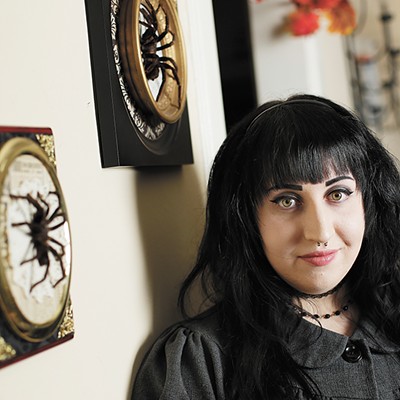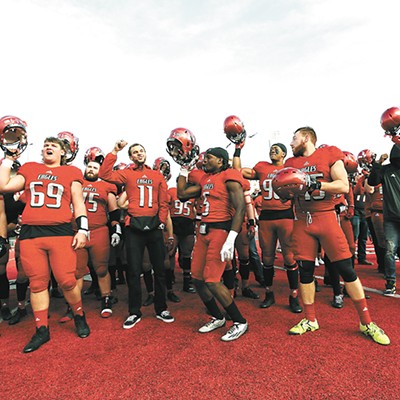We were the first family in Montana to have television. There are those perhaps in a better position to know — my mother, for instance — to whom this claim is suspect, but consider: Montana didn’t have broadcast television until KXLF (at the time, sister station of Spokane’s KXLY) went on the air in Butte in August 1953. My father sold televisions for Westinghouse and he immediately laid claim to the display model when it arrived on the sales floor in 1952. You might say he was both buying and selling the first television in Montana with the same move. This was more than a year before the display model had anything to display, other than the peppery off-the-air electrical snow of the day and its own splendor as a piece of furniture.
The set was beautiful, with these brass-handled mahogany doors for hiding the glassy cyclopean eye of the screen, maybe so you could decently put the thing to sleep at night with the rest of the household. Or maybe the idea was that if television didn’t happen to stick, proved to be but a fad, why, you’d still have something nice. (In fact, many years later I met a couple who turned a similar set into a fine aquarium.)
But my dad made his living selling electrical things, and we ended up with all manner of the latest devices. We had electric toothbrushes and little battery-operated portable fans. We were among the first in our neighborhood to have a blender, a deep-fat fryer and a tape recorder. We had an electric knife, which worked OK until the dual blades popped out of sync and nobody knew how to fix them. When our new electric can opener arrived, my sister Cathy was instantly enamored; she proceeded to open almost every can in the cupboard. Fortunately, we had enough Tupperware containers to handle the sudden overload of perishable foodstuffs.
I remember getting a transistor radio that was the usual shirt-pocket size — it played music, of course, but it also included a cigarette lighter and a clock and a flashlight, and it was rechargeable, the first time I’d ever seen that. Looking back, I’m anachronistically impressed: Why, that little radio was chockablock with killer apps — a primordial prototype of such handheld millennial marvels as the Blackberry and the Star Trek phaser.
My dad shaved with an electric razor, and it was years before I realized you could shave with anything else. I even received a battery-operated electric toy razor for Christmas one year. The thing didn’t have a blade, of course, but it buzzed and tingled and gently encouraged my peach fuzz. Unfortunately, the kit also included a bottle of make-believe aftershave that made my skin break out.
We were plenty electrical, all right — but we never lived in a Medallion Home.
Medallion Homes represented the apex of the electrical industry’s “Live Better Electrically” campaign of the 1950s. When you lived in an all-electric house, you were entitled to have a “Live Better Electrically” medallion emblazoned on your wall, or incorporated into your clock or your doorbell. But my dad had drawn the line with electric heat. Sentiment aside, natural gas was simply a better deal.
Another problem was that the LBE campaign was spearheaded by General Electric, Westinghouse’s mortal enemy. GE even lent their star, Ronald Reagan, to the effort, and when he wasn’t hosting General Electric Theater, he was traveling to electrical association conventions to glad-hand the fellows and dance with the gals — including my mother.
The enmity between the two corporations went back a long way — back to Thomas A. Edison himself, a General Electric founder — and George Westinghouse.
Now, of course, Edison was American electricity’s great hero, short on formal education but long on ingenuity, pluck and stick-to-it-iveness. And what he couldn’t do with electricity, one of his fictional doppelgangers could: Tom Swift had his Electric Runabout … and his Electric Locomotive … and his Electric Rifle.
But Edison could also play quite the creep, it turned out. He’d sunk his prestige and a great deal of money into developing a direct-current power system, and when George Westinghouse championed an alternating current system, the war of the currents was on. Edison secretly purchased Westinghouse AC generators, hooked them up to metal plates, and used them to electrocute stray dogs and cats, thoughtfully inviting the press to observe the grisly proceedings. He also secretly bankrolled the development of the electric chair, again making sure that everyone knew that Westinghouse’s AC was involved. In fact, he tried to replace “to electrocute” in the lexicon with “to Westinghouse.”
Well, AC proved to be a much better way to transmit power, and it won out. Still, you had the sense that electricity was really something in those days: a fetched-down, half-tamed bastard cousin to lightning. And that when the electrical projects of the time weren’t dastardly, they were heroic — dynamos and X-rays and lighting the night. Our age, by contrast, with our bits and nanos and pixels, seems all too refined.
Still, sometimes there are echoes of the old days. Take the Taser. You may think the name comes from an analogy with such devices as the phaser and the laser, and of course you’d be partially right. But the name also comes from a bit of whimsy indulged in by the makers: Thomas A. Swift’s Electric Rifle.





















